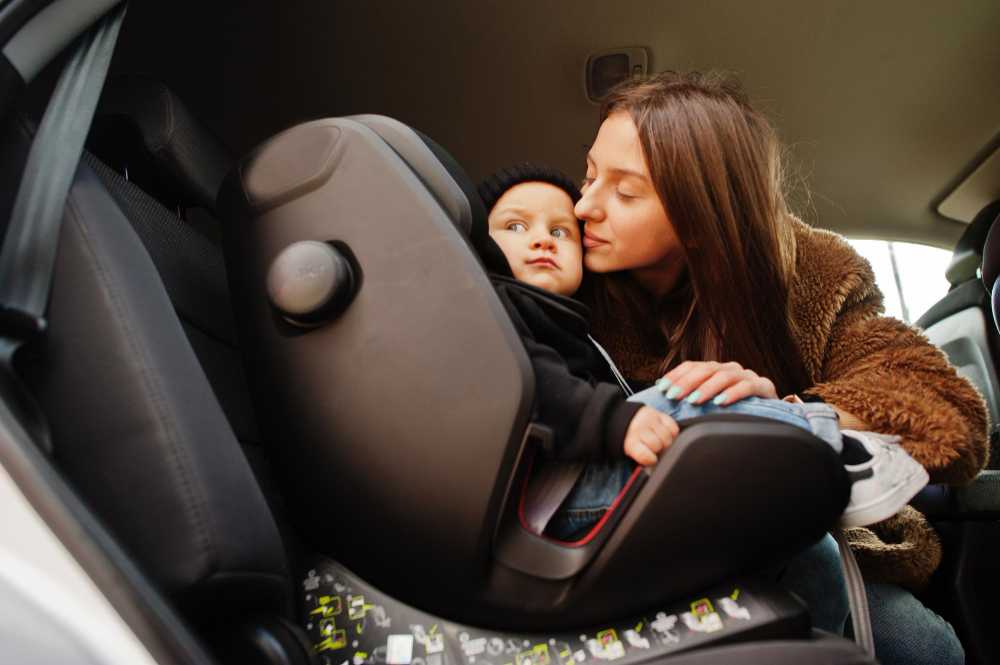A Comprehensive Guide to Single Cab Truck Car Seat Installation

A single-cab truck is a unique challenge to parents who aim to provide the safest travel conditions for their children. With no back seat to serve as a traditional spot for child safety seats, the question arises: can you put a car seat in a single cab truck? While single-cab trucks certainly have less room compared to other vehicles, it is still possible to safely install a car seat and transport your child in a single-cab truck. This ultimate guide will tackle the complexities and considerations you should take into account when attempting to accommodate a single cab truck car seat.
Understanding Single Cab Trucks
Single cab trucks, characterized by their compact size and a single row of seating, are popular choices for individuals who prioritize utility and functionality. These utilitarian trucks prioritize efficiency and cargo space, making them ideal for various tasks. However, their limited cabin space poses challenges, especially when it comes to accommodating passengers and, crucially, installing car seats. Recognizing the unique design and features of single cab trucks is fundamental for addressing the specific considerations involved in ensuring the safety of young passengers in these vehicles.
Safety First – The Importance of Single Cab Truck Car Seats
In single-cab trucks, where space is limited, the significance of car seats is heightened. These specialized car seats are not only a legal requirement in many jurisdictions but also serve as a crucial safety measure for the youngest passengers. The confined cabin space in single-cab trucks necessitates meticulous consideration of compact, well-fitted car seats to ensure optimal protection in the event of a collision. Prioritizing the installation of appropriate car seats is an integral aspect of responsible parenting, emphasizing the commitment to providing a safe and secure travel environment for children in these compact truck configurations.
Can You Put a Car Seat in a Single Cab Truck?
Yes, it is possible to install a car seat in a single cab truck, but it requires careful consideration and adherence to safety guidelines. Single cab trucks provide limited space, and the unique seating arrangement may present some challenges when installing a car seat. However, by choosing the right type of car seat and following proper installation procedures, it is possible to transport a child securely and safely in a single cab truck.
Here are some key points to consider when installing a single cab truck car seat:
Car Seat Types and Compatibility
Not all car seats are suitable for a single cab truck. There are infant car seats, convertible car seats, and booster seats, each designed for specific age brackets and weight classes. Check your car seat manufacturer’s guidelines to see if your model is approved for use in a single-cab truck. Compatibility with your vehicle’s seat belts or LATCH (Lower Anchors and Tethers for Children) system is also essential.
Select a car seat that is suitable for single-cab trucks. The limited space and seating arrangement may present some challenges when installing a single cab truck car seat. However, there are different types of car seats that are suitable for single-cab trucks, each designed to accommodate the specific needs of a child and the space constraints of the vehicle.
Infant Car Seats
Infant car seats are designed facing the rear to ensure optimal protection for the baby during a crash. These car seats come in compact sizes, making them suitable for installation in single-cab trucks. They are also designed for rear-facing installation, occupying less space than their forward-facing counterparts. Moreover, certain infant car seats are crafted to work with a permanently installed base, facilitating convenient attachment and removal of the car seat as required.
Convertible Car Seats
Convertible car seats are designed to accommodate both rear-facing and forward-facing positions, making them a versatile option for single-cab trucks. While these car seats may be larger than infant car seats, they can still be installed in a single cab truck by utilizing the rear-facing position to maximize space. Once the child outgrows the rear-facing position, the convertible car seat can be adjusted to the forward-facing position, providing extended use as the child grows.
All-in-One Car Seats
Versatile all-in-one car seats are crafted to adapt seamlessly to rear-facing, forward-facing, and booster seat configurations, presenting a holistic approach to child safety throughout their developmental stages. Although these car seats may be larger and demand more space, they can still be effectively installed in a single cab truck by utilizing the rear-facing position during infancy and toddlerhood. As the child grows, the car seat can be adjusted to the forward-facing and, eventually, the booster seat position, providing long-term use in a single cab truck.
Seat Size and Space
Evaluate the available seat size and space in the single-cab truck. Ensure that the car seat fits comfortably within the limited cabin space without compromising on safety or obstructing other passengers or the driver.
Follow Manufacturer Guidelines
Refer to the owner’s manual of the single cab truck for specific instructions and guidelines regarding the installation of car seats. The vehicle’s manual can provide specific recommendations on seating positions, seat belt usage, and any other considerations for a car seat installation. Additionally, adhere to the car seat manufacturer’s instructions to ensure the car seat is securely attached to the vehicle seat and compatible with the single cab truck’s seating configuration.
The Vehicle’s Installation Features
Identify and understand any installation features in the single cab truck that may affect the installation of a car seat. This includes the presence of a center console, irregular seat shapes, or any other features that might impact the installation process.
Installation Method
Follow the recommended installation method outlined in both the vehicle owner’s manual and the car seat manufacturer’s instructions. This may involve using the vehicle’s seat belt or the LATCH system, depending on the specific guidelines provided. Follow the specific guidelines provided by the vehicle manual and the car seat manufacturer for single cab truck car seat installation.
Vehicle Model/Make Year
Different vehicle models and make years may have variations in their interior design and safety features. Be aware of any specific considerations or guidelines provided by the truck’s manufacturer for installing car seats.
Condition of the Airbag
Check the airbag status, especially if installing a front-facing car seat in the front seat. Many modern vehicles have a switch for disabling the passenger airbag—a necessary feature if a car seat is to be placed in the front. If your single cab truck is equipped with front-seat airbags, ensure the airbags are deactivated when installing a rear-facing car seat in the front passenger seat.
State Car Seat Laws
Each state and country has specific laws regarding car seats, including regulations for their use in different types of vehicles. Before you proceed, consult your local laws to ensure that placing a car seat in your single cab truck is legal. Some jurisdictions might prohibit the installation of a single cab truck car seat in the front seat or have specific requirements that make it challenging.
Single Cab Truck Car Seat Laws by States
Single cab trucks provide limited space, which can present unique challenges when it comes to installing car seats. Familiarizing yourself with your state’s specific car seat laws and regulations is crucial to ensuring the safety of your children while traveling in a single cab truck. Below are the car seat laws and regulations for single cab truck car seats in various states:
Alabama
In Alabama, children under the age of 6 are required to be placed in a car seat or booster seat. The specific requirements for installation in single cab trucks may vary, but it is important to follow the manufacturer’s guidelines and ensure that the car seat is securely installed.
California
California’s stringent car seat laws mandate rear-facing seats for infants under two years old and appropriate restraint systems for children up to eight years old. Understanding these regulations is crucial for ensuring compliance and the safety of young passengers in single-cab trucks.
Florida
In Florida, children under the age of 5 are required to be secured in a car seat or booster seat. Parents and caregivers should follow the manufacturer’s instructions for installing car seats in single cab trucks and ensure that the child is safely seated according to the state’s regulations.
Georgia
Georgia law stipulates that children under the age of eight must be placed in a car seat or booster seat unless they are 4ft 9 inches tall. When traveling in single cab trucks, parents and caregivers should carefully install the car seat in compliance with the state’s regulations.
Louisiana
Louisiana law requires children under the age of 6 to be secured in a car seat or booster seat. When installing car seats in single cab trucks, it is important to follow the manufacturer’s guidelines and ensure that the seat is securely placed according to the vehicle’s specifications.
Michigan
Michigan’s car seat laws require rear-facing seats for infants and toddlers up to two years old. Compliance with these guidelines is essential for those utilizing single-cab trucks to transport young passengers.
Missouri
Missouri law emphasizes the use of child restraint systems for children under eight years old. Comprehending these regulations is vital for parents and caregivers using single-cab trucks to ensure the safety and well-being of young passengers.
New York
New York’s car seat laws are comprehensive, requiring rear-facing seats for infants up to two years old and appropriate restraint systems for children up to eight. Single cab truck owners should familiarize themselves with these regulations to prioritize child safety.
Oklahoma
In Oklahoma, children under the age of eight or below 4 ft 9 inches tall must be secured in an appropriate booster seat or car seat. When installing car seats in single cab trucks, parents and caregivers should adhere to the state’s regulations.
South Carolina
South Carolina’s car seat laws require the use of child restraint systems for children under eight years old. Understanding these regulations is crucial for parents and caregivers using single-cab trucks to transport young children.
Tennessee
In Tennessee, children under the age of 9 must be placed in a car seat or booster seat. When traveling in single cab trucks, parents and caregivers should ensure that the car seat is installed according to the state’s regulations.
Texas
Texas car seat laws require the use of child restraint systems for children under eight years old. Understanding and adhering to these guidelines is essential for those driving single cab trucks with child passengers in the state.
Parents and caregivers must acquaint themselves with the individual car seat laws and regulations applicable in their respective states. It is equally crucial to confirm that the car seat is not only correctly installed but also securely positioned within single cab trucks.
Safety Challenges and Solutions of a Single Cab Truck Car Seat
Car seats, designed to meet stringent safety standards, often demand a certain amount of room for proper installation. Single cab trucks, with their compact cabins, may seem ill-suited for this purpose. Installing a single cab truck car seat may pose some challenges, but with careful consideration and adherence to safety guidelines, these challenges can be overcome. Here are common challenges and their solutions:
Limited Legroom
Single-cab trucks often have limited legroom, making it challenging to find the right angle for rear-facing car seats. To address this, opt for a compact car seat designed for smaller spaces can be a practical solution. These car seats are often more streamlined without compromising on safety, making them suitable for single cab trucks.
Single Row Seating
With only one row of seating, the placement of the car seat becomes crucial. Installing the car seat in the center position is ideal for both safety and stability.
Access to the Child
In single cab trucks, accessing the child in the car seat may require some maneuvering. Consider placing essential items within easy reach and ensure that the driver can check on the child without distraction.
Storage Space
The limited cabin space in single-cab trucks may impact the availability of storage space. Opt for compact car seats that don’t compromise the remaining space and use organizers or other storage solutions to keep essentials within reach. Securely store bulky items such as strollers, diaper bags, and other child-related gear to prevent them from becoming projectiles in the event of a sudden stop or crash.
Airbag Safety
If the single cab truck is equipped with front-seat airbags, disabling the airbags when installing a rear-facing car seat in the front passenger seat is important. Since airbags can pose a serious risk to young children in a crash, following the vehicle and car seat manufacturer’s recommendations for airbag safety is essential.
Potential Solutions
Follow Manufacturer Guidelines
Before attempting to install a car seat in a single cab truck, it is crucial to consult both the truck and car seat manufacturer’s guidelines. These guidelines provide specific instructions on proper installation and ensure compliance with safety standards.
Use the Right Car Seat
Car seats come in various types, including rear-facing infant seats, forward-facing seats, and booster seats. Choose a car seat that is appropriate for the age, weight, and height of the child. Ensure that the car seat is compatible with the limited space in a single cab truck.
Secure Installation
Proper installation of the car seat is paramount for ensuring the safety of the child. Follow the installation instructions meticulously, and make use of additional accessories, such as seat belt extenders or locking clips, if required.
Check for Compatibility
Some single cab trucks may have unique features that affect car seat installation, such as the presence of a center console or irregular seat shapes. It is essential to check for compatibility and make any necessary adjustments.
Front-Facing Installation
In some cases, installing a front-facing car seat might be more feasible than a rear-facing one. However, it is crucial to ensure that the airbag is deactivated when using a front-facing car seat in the front seat of a single cab truck to prevent potential injury.
Front vs. Back Seat
While the front seat may be an option for installing a car seat in a single cab truck, the back seat is generally considered the safest location for a child to ride. If the single cab truck is only equipped with front seating, take extra precautions to ensure that the car seat is securely installed and that airbag safety measures are followed.
Custom Seat Modifications
Depending on the model of the single cab truck, it may be possible to explore custom modifications to the seat or cabin to create additional space for a car seat. However, any modifications should be carried out by professionals to maintain safety standards.
Regular Inspection
Regularly inspect the car seat and its installation to ensure that it remains secure and in good condition. Check for any signs of wear, damage, or loose fittings, and make any necessary adjustments or replacements as needed.
Installation Tips for a Single Cab Truck Car Seat
When installing a car seat in a single cab truck, there are several important factors to consider to ensure a secure and safe installation. Follow these installation tips to properly install a car seat in a single cab truck:
Evaluate the Space
Before installing a car seat, evaluate the available space in the single cab truck to determine the best location for the car seat. While the limited space may present challenges, it is important to prioritize safety and ensure that the car seat is installed in a position that allows for proper installation and secure attachment.
Check the Vehicle’s Manual
Refer to the vehicle manual to determine the specific requirements and recommendations for installing a car seat in the single cab truck. The manual may provide important information on seating positions, seat belt systems, and any specific considerations for single cab trucks.
Use the Correct Installation Method
When installing a car seat in a single cab truck, it is essential to use the correct installation method recommended by the car seat manufacturer and the vehicle manual. This may involve utilizing the seat belt system or the LATCH (Lower Anchors and Tethers for Children) system to secure the car seat in place.
Ensure a Secure Fit
Once the car seat is installed, ensure that it is securely fastened and does not have excessive movement or wobbling. A properly installed car seat should fit snugly in the vehicle seat, with minimal to no movement from side to side or front to back.
Follow the Car Seat Manual
Always refer to the car seat manual for specific installation instructions and guidelines. The car seat manual will provide detailed information on how to properly install the car seat in a single cab truck, including any specific considerations or limitations for the vehicle.
Seek Professional Assistance
If you’re unsure about the proper installation of a single cab truck car seat or have any concerns about its safety, seek assistance from a certified child passenger safety technician. These experts can provide personalized guidance and assistance to ensure that the car seat is installed correctly and provide you with peace of mind for your child’s safety.
With these tips, you can ensure that your child is safely secured while traveling in your single-cab truck. Proper installation of a car seat is crucial for your little one’s safety, so take the time to carefully follow the guidelines and seek professional assistance if needed. By prioritizing safety and following the appropriate installation procedures, you can confidently transport your child in your single-cab truck while ensuring their well-being is paramount.
Final Thoughts
Installing a single cab truck car seat entails navigating a series of specific requirements and precautions. Given the inherent limitations and risks, a higher degree of due diligence is required to ensure the safety of child passengers. By following the guidelines provided in this ultimate guide and remaining vigilant about safety, you can transport your child in your single cab truck with confidence.
Remember to continually review safety procedures, keep abreast of legal requirements, and prioritize the well-being of your smallest passengers on every trip. With the correct approach and an unwavering commitment to safety, even the humble single-cab truck can serve as a vessel for precious cargo.





